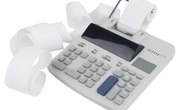
Mortgage lenders use discount points to make small adjustments in the projected return from loans and to give borrowers different rate and payment options. In lender jargon, one point is 1 percent of the loan amount. The dollar value of points can be quickly calculated. Some additional math will give you comparison figures to help you decide whether it makes sense to pay more points for a lower rate or go with less points and accept a higher mortgage interest rate.
Obtain current discount point amounts with associated home loan rates from a mortgage lender. A lender sets the points it will charge for a range of interest rates. For example, a loan at 5 percent may be listed at zero points, a 4.75 percent mortgage costs one point and a 4.5 percent loan requires the payment of 2.5 points.
Multiply your projected loan amount times the points for a specific interest rate. The result will be the dollar amount added to the loan closing costs for the selected interest rate. Using the example rates and a $250,000 loan, the one point for a 4.75 percent rate would equal $2,500 and the 2.5 points at 4.5 percent equals $6,250.
Calculate or ask the mortgage lender for the principal and interest payment amounts at the different interest rates on your discount points list. Using the example rates with a 30-year, $250,000 loan, the payments would be $1,342.04 per month, $1,304.12 per month and $1,266.71 per month for rates of 5 percent, 4.75 percent and 4.5 percent, respectively.
Divide the cost of points by the monthly payment difference to calculate a pay back period if you choose a lower rate and the payment of points. In the example, lowering the rate from 5 to 4.75 percent reduces the payment by $37.92 per month. The lower rate costs one point or $2,500 and dividing the points cost by the payment savings shows that it will take 66 months for paying the points to pay off.
Tips
Typically, one discount point covers a 0.25 percent change in the loan rate. However, lenders are free to set discount points at any level and you will find different lenders charging different points amounts for the same rate. Paying points for a lower rate makes sense if you need a lower payment to qualify for a loan or plan to stay in the home for longer than the break-even number of months. If you lock in a mortgage rate you should make sure that the points are also locked. If not, the lender could increase the points if rates go up before you can close on the new mortgage.
References
Tips
- Typically, one discount point covers a 0.25 percent change in the loan rate. However, lenders are free to set discount points at any level and you will find different lenders charging different points amounts for the same rate.
- Paying points for a lower rate makes sense if you need a lower payment to qualify for a loan or plan to stay in the home for longer than the break-even number of months.
- If you lock in a mortgage rate you should make sure that the points are also locked. If not, the lender could increase the points if rates go up before you can close on the new mortgage.
Writer Bio
Tim Plaehn has been writing financial, investment and trading articles and blogs since 2007. His work has appeared online at Seeking Alpha, Marketwatch.com and various other websites. Plaehn has a bachelor's degree in mathematics from the U.S. Air Force Academy.

